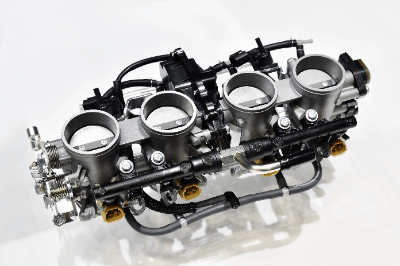What Is a Throttle Valve?

A throttle valve is a valve installed in the passage of a fluid. Throttle valves adjust the flow of fluid by changing the cross-sectional area of the passage. They are primarily used to regulate the amount of air intake into the engines of automobiles, motorcycles, aircraft, and agricultural machinery. In automobiles, the degree of opening and closing of the throttle valve is adjusted by the accelerator pedal. In the past, throttle valves were controlled using a wire in a system known as mechanical throttle, but in recent years, electronic throttle systems have become more common, where the degree of valve opening and closing is electronically controlled.
Uses of Throttle Valves
Throttle valves are mainly used in automobiles, motorcycles, aircraft, and agricultural machinery. This section will focus on their use in automobiles.
In automobiles, throttle valves are attached to the throttle body in the air intake passage (intake pipe) and regulate the amount of air intake into the engine to control power output. Throttle valves can be single or multiple, with each installed in a single throttle body.
Throttle valve adjustment is typically done using the accelerator pedal. In the past, the valve was opened and closed using a wire mechanism, but in recent years, electronic systems have taken over. The engine’s Electronic Control Unit (ECU) adjusts the valve based on driving conditions and the position of the accelerator pedal.
Principles of Throttle Valves
Let’s explain the principle of throttle valves using an automobile as an example. Throttle valves are attached to the throttle body in the intake air passage (intake pipe). When the accelerator pedal is pressed, the degree of valve opening/closing is adjusted to control the amount of intake air entering the engine. There are two main types of throttle valves: butterfly valves and slide valves, each with its own working principle.
- Butterfly Valve: This type of valve is circular and installed in the intake air passage. It rotates vertically in response to the position of the accelerator pedal to control the degree of valve opening and closing.
- Slide Valve: Slide valves are flat, plate-shaped valves installed in the intake air passage. They open and close based on the degree of acceleration, thus controlling the degree of valve opening and closing.
Throttle valves can be operated mechanically or electronically. - Mechanical Throttle: In this system, the throttle pedal and throttle valve are connected by a wire. The valve opens and closes according to the pressure applied to the accelerator pedal.
- Electronic Throttle: In this system, the pressure applied to the accelerator pedal is converted into an electrical signal, which is then transmitted to the engine ECU. The degree of valve opening/closing is adjusted considering various factors, such as driving conditions, fuel consumption, and exhaust emissions.
Throttle Valve Failure
Throttle valves play a role in reintroducing and reusing a small amount of dust and exhaust gases that cannot be prevented by the air cleaner, delivering clean air into the engine (EGR), and managing a re-combustion system (PCV) for gases that leak slightly from the gap between the cylinder and piston due to incomplete combustion (blow-by gas). The combination of these three elements can lead to a gradual buildup of carbon and sludge.
This accumulation of debris can hinder normal operation, resulting in reduced fuel economy, unstable idling, and reduced power output. In severe cases, it can even prevent the engine from starting.
In the case of electronic throttle systems, which are prevalent in modern cars, the computer can adapt to some extent to a dirty throttle valve. However, periodic cleaning is still necessary to maintain the system’s performance in good condition.
It’s worth noting that diesel engines do not incorporate throttle valves in their design. In diesel engines, the throttle pedal controls the amount of fuel injected into the compressed air rather than the opening and closing of valves, making throttle valves unnecessary.
Sticking Throttle Valves
When carbon buildup prevents normal operation, it results in a condition known as “sticking” throttle valves, which can lead to engine malfunctions.
One method for cleaning a sticking valve involves disassembling it until it is exposed and then applying a special cleaner directly onto the valve. You can scrub it with a brush or wipe off the dirt with a rag.
To disassemble the valve, remove the duct connecting the valve to the air cleaner so that the valve is visible, and clean it in this condition. For thorough cleaning, remove the valve from the engine and work on it separately.
Various cleaners can be used, including engine conditioner, carburetor cleaner, and dedicated throttle valve cleaner.
After cleaning, it is important to reset the computer, which has adapted to the dirty conditions, to restore the original performance of the system.